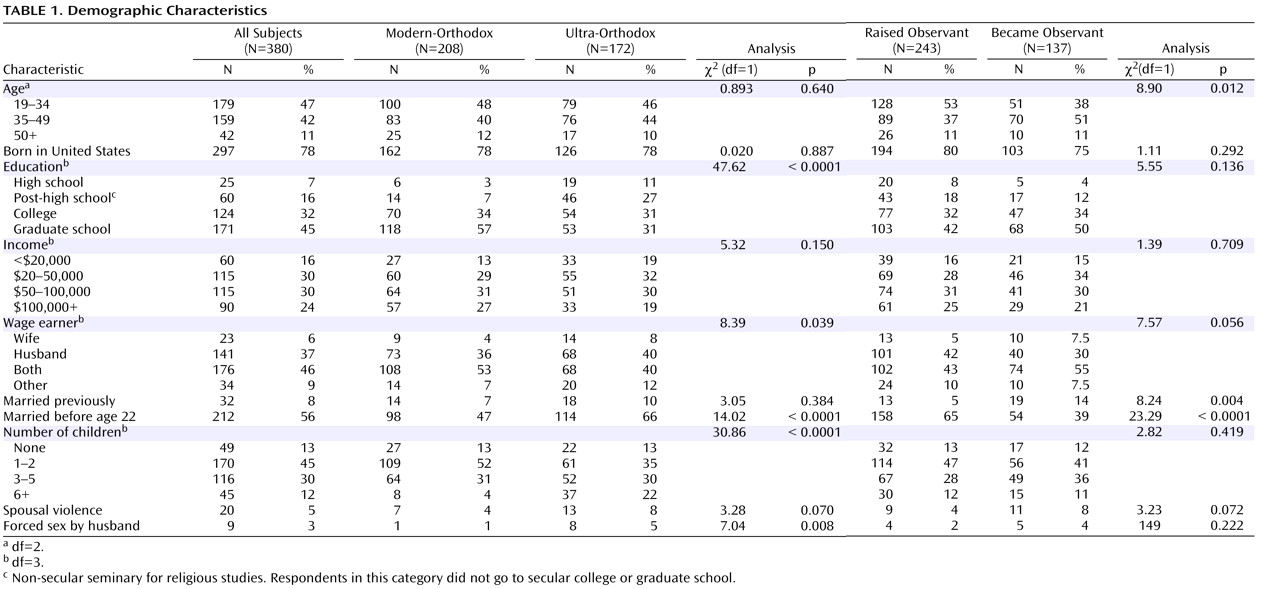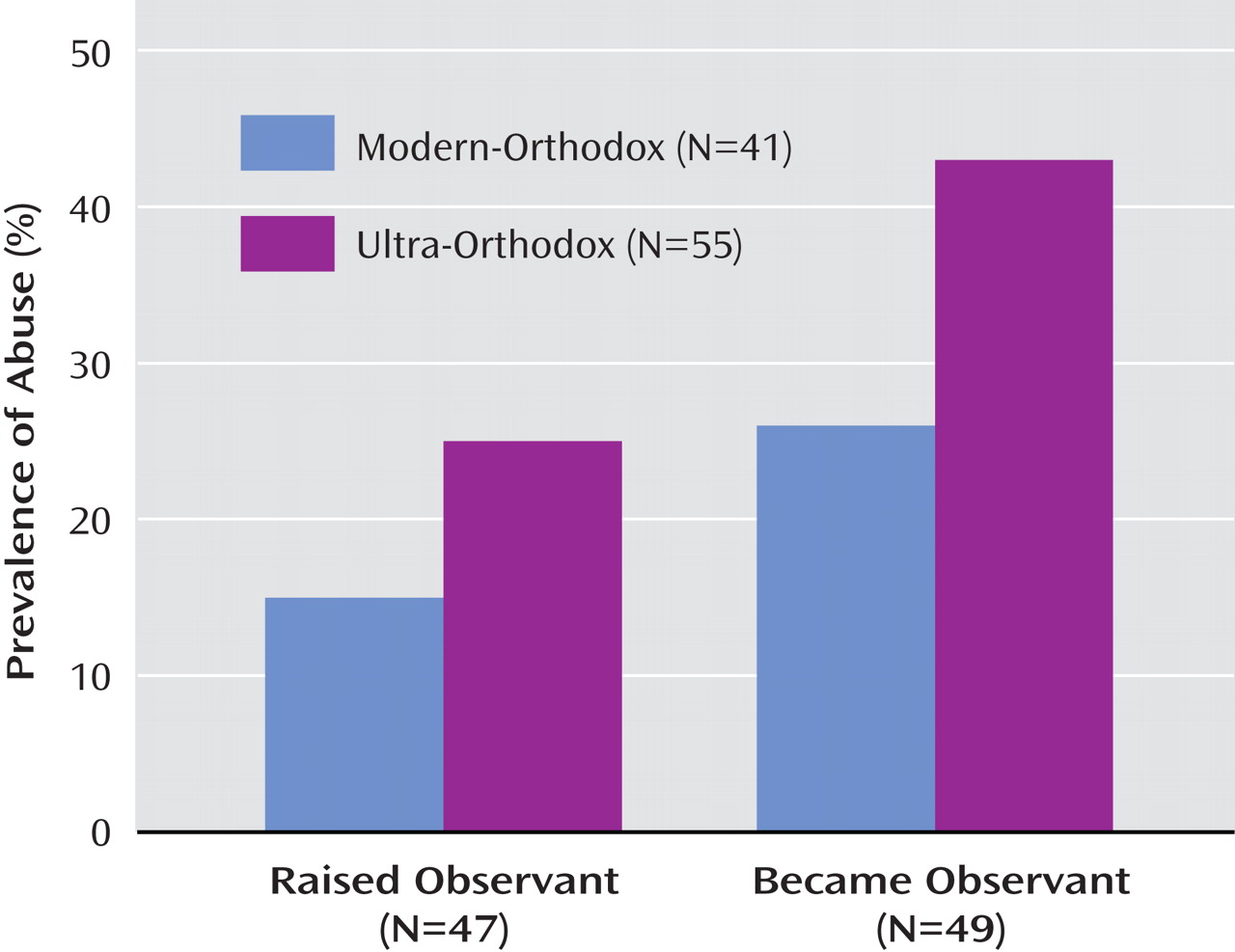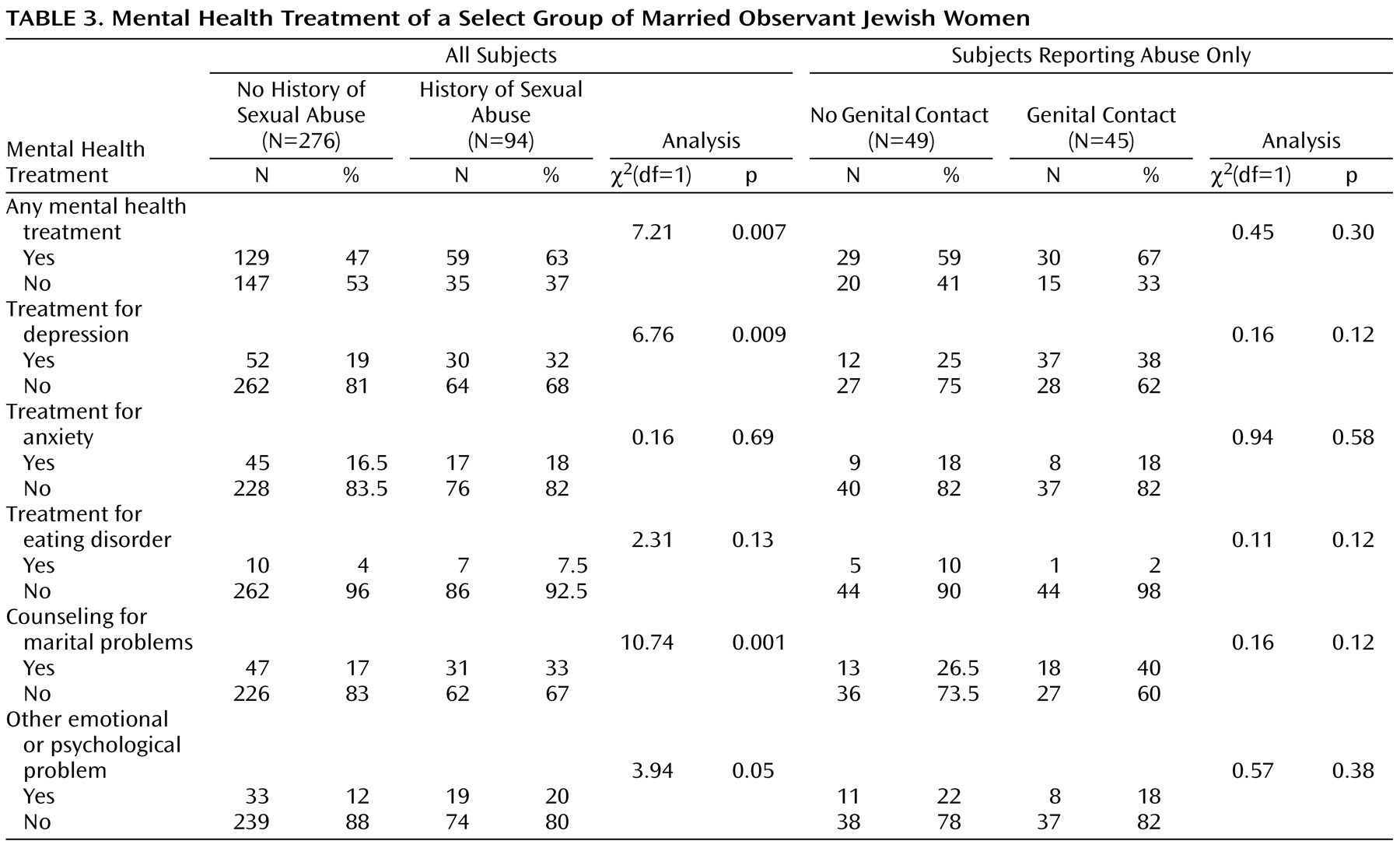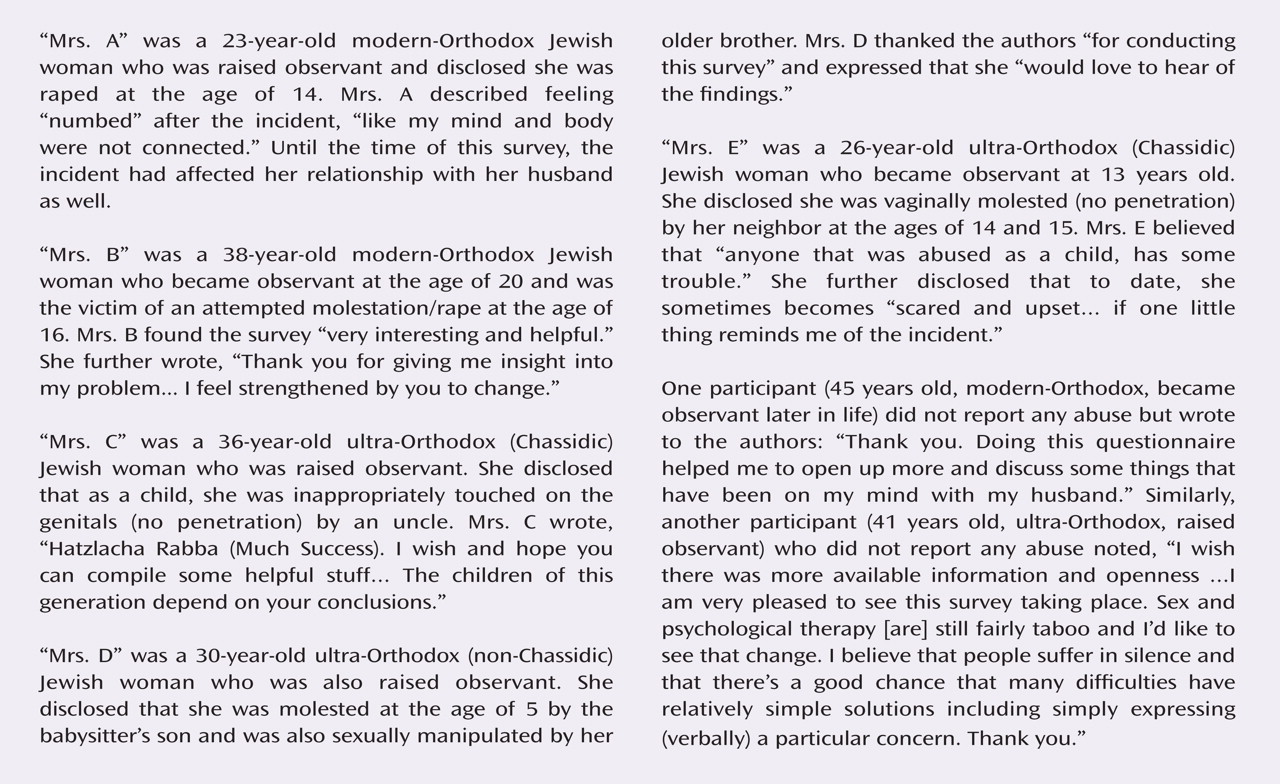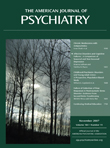Most studies investigating religiosity and sexual abuse have examined whether religiosity ameliorates the negative consequences of sexual trauma
(1 –
4), rather than whether religiosity affects the occurrence of sexual trauma. There are currently no statistics regarding the lifetime prevalence of sexual abuse within religious communities. Accordingly, it is not possible to know whether cultures that constrain sexual activity protect individuals from sexual abuse, increase occurrence of such abuse, or have no effect at all. In Orthodox Judaism, there are major constraints on sexual behavior compared with U.S. cultural norms, including a strict prohibition of premarital and extramarital physical contact of any sort
(5) . We examined the lifetime prevalence of sexual abuse in a group of self-reporting married Orthodox Jewish women. Data on abuse were collected as part of a larger study investigating sexual behavior and dysfunction. Because the subjects were recruited by advertisements, they were more self-selecting than subjects in a sampling frame-based survey. Thus, those who chose to participate may not be representative of the population.
Participants were categorized as either modern-Orthodox or ultra-Orthodox based on their self-reported religious affiliation. This subdivision reflects a debate within the Orthodox Jewish community. Unlike modern-Orthodox Jews, who actively participate in the general culture,
haredi Jews, or ultra-Orthodox Jews, embrace a theologically conservative outlook that advocates substantial separation from secular culture (
haredi literally means “one who trembles before God”)
(6) . This issue of openness versus insularity provided an additional basis for comparison within the subject group.
Method
Participants
Respondents were Jewish married women (N=380) ages 19 to 58. To be included in the study, the participant had to report regular use of a ritual bath (i.e., Mikvah), reflecting adherence to Orthodox Jewish law, which proscribes sexual contact during menstruation and for seven days thereafter
(7) . Subjects responded to a flier or advertisement asking married women to consider participating in an important research study conducted by the Mt. Sinai School of Medicine examining sexual life in marriage among observant Jewish women. The advertisements emphasized that the goal of the study was to gain a better understanding of sexual attitudes and practices, and that the study investigators believed that such knowledge could inform premarital education (Kallah) classes, as well as be useful for medical, mental health, and rabbinic professionals who treat and counsel observant Jewish women.
Design
This study was approved by the Institutional Review Board of the Mt. Sinai School of Medicine. Participants completed the questionnaire anonymously and without financial reward and returned it by postal or electronic mail. To obtain a diverse group of observant Jewish women, subjects were sought across a large range of religious Jewish communities by advertising through synagogue bulletins, Jewish organizations, newspapers, Jewish-oriented web sites and Listservs, and a network of medical professionals (e.g., obstetricians/gynecologists, nurses, and pediatricians) whose practices consisted of sizable numbers of Orthodox Jewish women. The design of this study did not allow us to estimate the number or characteristics of women who heard about the study and refused participation.
Questionnaire
The questionnaire developed for the participants was comparable to that used in the National Health and Social Life Survey
(8,
9), administered by the Sociometrics Corporation, with additional questions regarding religious affiliation and other specific questions related to sexual life within Orthodox Jewish communities. These additional questions were based on questions described comprehensively in documents available from the Sociometrics Corporation. This section of the questionnaire began by asking respondents the question “Did anyone ever touch you sexually in a way that made you feel uncomfortable?” and, if so, requesting a brief account of the incident. We excluded responses where the account itself concluded that abuse had not occurred, such as 1) when the situation was consensual, although uncomfortable (e.g., “Past boyfriends sometimes pushed too much. I do not consider it abuse, so maybe my original answer should be changed to no”), 2) when the account was of a nonconsensual but inconsequential event (e.g., “My father’s friend wanted to have sex with me,” or “A stranger fondled my backside on the street”), or 3) when the respondent did not describe the event in the follow-up questions used in the analyses (e.g., characteristics of the perpetrator[s], number of times abused, age of respondent and perpetrator at the time of abuse, and whether the abuse involved forced touching of genitals and/or penetration).
The National Health and Social Life Survey used examiners to ask further details about each experience; in this study, the questionnaire asked for personal relevant details.
Statistical Analysis
Chi-square tests were used to compare sociodemographic characteristics of the participants based on religious affiliation (modern- versus ultra-Orthodox) and whether the respondent was raised observant or became observant later in life.
Three dichotomous variables relating to sexual abuse were also considered: presence or absence of a history of sexual abuse, whether genital contact occurred in the abuse, and age at time of first abuse (“13 and below” versus “other”). We also examined characteristics of the abuse itself and its disclosure. Sexual behavior within the marriage was noted but not assessed for possible abuse.
Results
Table 1 shows the demographic characteristics of the respondents, as well as subgroup comparisons between modern- and ultra-Orthodox Jewish women and between women who were raised observant and those who became observant later in life. There were no significant differences between modern- and ultra-Orthodox respondents in age, birthplace, income, or prior marriages. However, compared with modern-Orthodox women, ultra-Orthodox women were more likely to have ended their education with high school or 1 year of religious seminary and were less likely to pursue graduate education, although the percentage of those with graduate education was higher among ultra-Orthodox women who were not raised observant (became observant: χ
2 =11.4, df=3, p=0.10; raised observant: χ
2 =36.8, df=3, p<0.0001). Although there were no differences in income level, ultra-Orthodox women were more likely to report being the sole wage earner or being supported by a source other than self or spouse. Ultra-Orthodox women were also more likely to be married by the time they were 22 years old and more likely to have six or more children than were their modern-Orthodox peers. Very few of the women reported experiencing domestic violence. More ultra-Orthodox women endorsed being forced by their husbands to have sexual relations.
The proportion of women who reported being raised observant did not differ between modern- (63%) and ultra-Orthodox (65%) women (χ 2 =0.186, df=1, p=0.66). There were no differences in birthplace or income between respondents who were raised observant and who became observant later in life. However, there was a significant effect of age, as a greater proportion of younger participants were raised observant, and a greater proportion of participants between the ages of 35 and 49 reported becoming observant. Women who became observant were also significantly older at the time of marriage and had more often been married before.
Twenty six percent of respondents reported experiencing at least one instance of sexual abuse. There was significantly greater reporting of sexual abuse by ultra-Orthodox women compared with modern-Orthodox women (χ
2 =5.88, df=1, p=0.015). The comparison was repeated and the women reporting abuse were subdivided into two groups: those abused by the age of 13 and those abused after this age. More ultra-Orthodox women than modern-Orthodox women reported their first abuse at or before the age of 13 (χ
2 =7.37, df=2, p=0.025). Report of sexual abuse was nearly twice as high among Jewish women who became observant compared with those raised observant (χ
2 =6.98, df=1, p=0.008). More incidents of abuse were reported by ultra-Orthodox women than modern-Orthodox women, both for those raised observant (χ
2 =4.06, df=1, p=0.04) and for those who became observant and for whom the abuse preceded increased religiosity (χ
2 =4.23, df=1, p=0.04) (
Figure 1 ). As seen in
Figure 1, religious affiliation and being raised observant were not related. When controlling for whether or not the subject was raised observant, stepwise logistic regression showed a higher proportion of sexual abuse for ultra-Orthodox women than modern-Orthodox women (χ
2 = 7.79, df=1, p=0.005), and a higher proportion of abuse for those participants who became observant later in life, whether affiliated with ultra- or modern-Orthodox Judaism (χ
2 =12.59, df=1, p<0.0005).
Table 2 shows the characteristics of the sexual abuse for the respondents who reported being abused. Among those who reported sexual abuse, half reported a single incident of abuse and half reported multiple incidents. Regarding the nature of the abuse, 48% reported genital contact/penetration, whereas 52% reported incidents of molestation (e.g., inappropriate fondling of the breasts and buttocks or attempted rape, which the respondent reported successfully fleeing). For 23% of sexually abused women, the abuse was perpetrated by a stranger. For 40%, the abuse was perpetrated by someone known to the respondent but not a family member, and for 30%, the abuse was perpetrated by a relative. Only 35% of respondents disclosed the abuse to another person, with 13% disclosing the event to their mother and 6% to their father. When the respondents were subdivided on the basis of whether they were raised observant, those raised observant were more likely to have been abused by strangers and were more likely to report incidents involving genital contact/penetration than those who become observant later in life.
Fifty one percent of the respondents reported receiving mental health treatment during their lifetime. The specific conditions for which respondents sought treatment were depression (22%), anxiety disorders (17%), eating disorders (4%), marital problems (21%), and other emotional or psychological problems (14%). Analyses based on religious affiliation and upbringing did not yield significant results, with the exception that persons who became observant sought more treatment for other emotional or psychological problems.
Table 3 shows that respondents who reported sexual abuse were more likely to report seeking mental health treatment than those who did not report abuse, with significant differences for depression, marital problems, and emotional or psychological problems in general. Whether or not the abuse involved genital contact did not differ between those who did and did not report mental health treatment.
Discussion
While observant Jewish women live in a culture with a clearly prescribed set of laws designed to regulate sexual contact, sexual abuse still exists in these communities. Indeed, 26% of the participants in this study reported lifetime sexual abuse, with 16% reporting abuse occurring by the age of 13. Almost a third of the participants reported sexual abuse perpetrated by relatives, and less than a quarter reported sexual abuse perpetrated by strangers. These estimates are consistent with data from several national surveys, in which 25%–27% of women, regardless of marital status or religious affiliation, reported sexual abuse
(10 –
12) . A meta-analytic study by Gorey and Leslie concluded that approximately 22% of women report childhood sexual abuse, a figure slightly higher than was noted in the present study, with about one-third reporting genital penetration
(13) . Additionally, more ultra-Orthodox women reported sexual abuse than modern-Orthodox women.
Although health professionals may be reluctant to inquire about sexual abuse in order not to offend patients for whom such topics are considered improper, it may be particularly important to screen for sexual abuse, since only one-third of the participants in this study reported disclosing the abuse to someone else. However, while the possibility of past abuse should be probed, it is also critically important to understand that the threshold at which someone may feel the victim of sexual abuse may be lower for those living in a more restrictive religious community. Approximately half of the reported incidents of abuse in this study did not involve genital contact. Since many researchers have historically defined sexual abuse as genital contact or even penetration
(14), there might be a tendency to minimize the significance of reported experiences that do not involve genital penetration. Recent observations—which found that the effect of sexual trauma may depend less on the characteristics of the abuse itself and more on factors such as the relationship of the victim to the perpetrator and the family and community environment within which the abuse occurs—support the use of less restrictive criteria, particularly if the goal of such studies is to determine the impact and health consequences of sexual abuse
(15,
16) . Indeed, for the respondents in this study, a history of abuse was related to a greater prevalence of mental health treatment, including treatment for depression, marital problems, and some other emotional and psychological problems, consistent with reports
(17,
18) . There were no differences in seeking mental health treatment between sexually abused women who did and did not report abuse involving genital contact.
The higher proportion of reported abuse among women who became observant versus those raised observant is also significant. For Jewish women, the decision to become observant of the dictates of Orthodox Judaism involves a comprehensive change in lifestyle, which almost always includes a manifest restriction in sexual behavior. Furthermore, those who choose to affiliate with ultra-Orthodox Judaism undertake an additional isolation from the surrounding culture
(6) . While the decision to increase religious observance may be motivated by many factors, it is noteworthy that of the respondents who became observant later in life and were not sexually abused, 60% were affiliated with modern-Orthodox Judaism, while among those who were sexually abused, only 43% were. Thus, women who are sexually abused or threatened may be more likely to seek out a more structured and sexually restricted lifestyle.
A major limitation of this study is that it was not feasible to obtain a representative sample of observant Jewish women, since no sampling frame was available. It was also not feasible to limit a representative sample of the general population to just observant Jewish women. This study used a wide variety of recruitment methods to provide coverage of the target population, which was married Jewish women who observe the strict laws associated with Orthodox Judaism, namely proscribed sexual activity except within marriage. We do not, therefore, claim that this study group is representative of all observant Jewish women. On the contrary, the high level of education, even among the ultra-Orthodox, suggests a sampling bias that may be associated with a willingness to participate in research. Furthermore, there was a high proportion of subjects receiving mental health treatment in this group, which may also reflect an openness to discussing sensitive topics with others. Despite these potential sampling biases, the respondents were unquestionably from a population that is substantially different from normative Western secular culture. To obtain a more complete picture of the role of sexual abuse in the Orthodox Jewish community, it would be necessary to also examine sexual abuse among unmarried observant women, since a history of sexual abuse is known to affect the capacity for intimacy or trust in close relationships
(14 –
16) . Similarly, since more than half of Jews who were raised Orthodox no longer affiliate with Orthodox Judaism as adults
(19), it would be necessary to examine the lifetime prevalence of sexual abuse in Jewish women who were once observant but are no longer so. For all of these reasons, the estimates of prevalence of sexual abuse reported here are not the actual prevalence of sexual abuse among Orthodox Jewish women.
Despite these limitations, we are not aware of any other study examining sexual abuse in the Orthodox Jewish community or in any other similarly insular religious society. This may be due to laws governing modesty, which discourage public or even private discussions of sexuality
(5) . We have received numerous comments on the survey from respondents expressing gratitude for this forum and suggesting support for further discussion in this area (Participant Perspective).
